#Philco Television Playhouse
Explore tagged Tumblr posts
Text
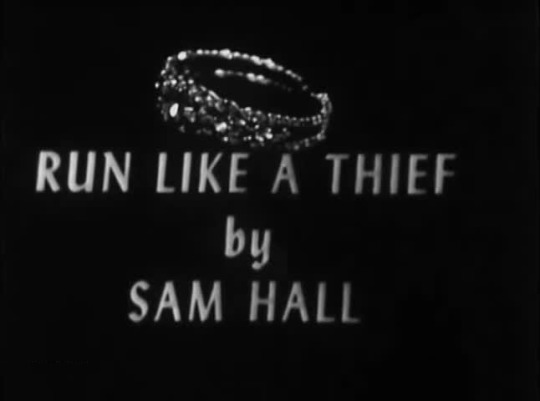

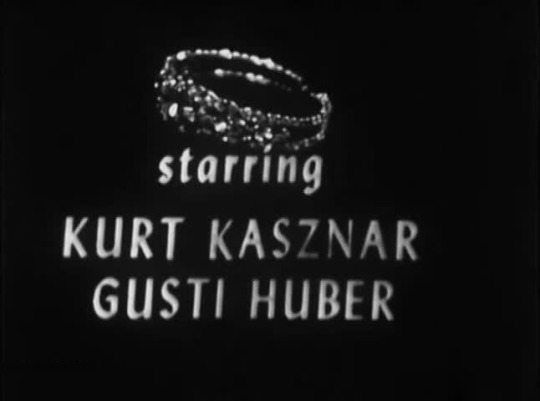
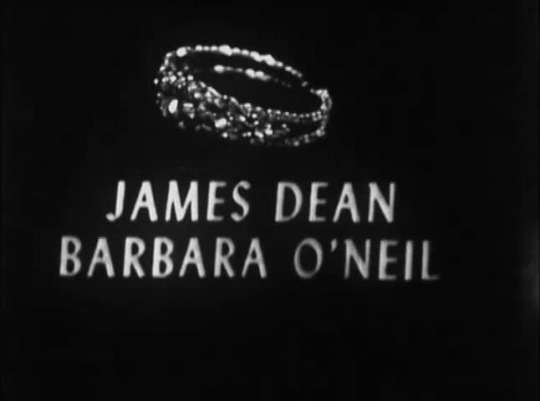
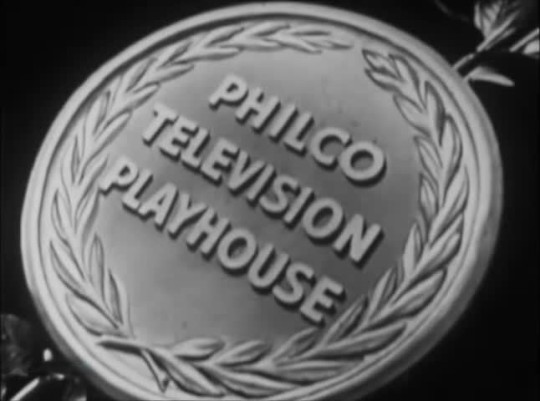
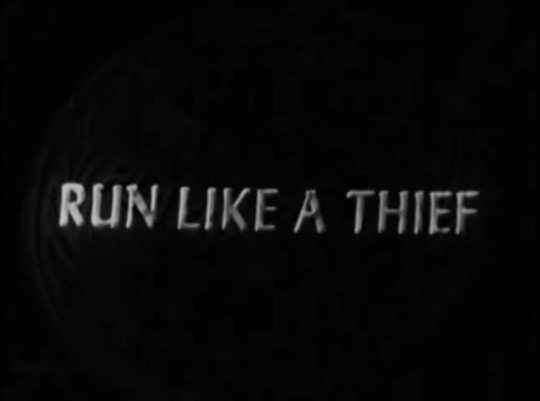

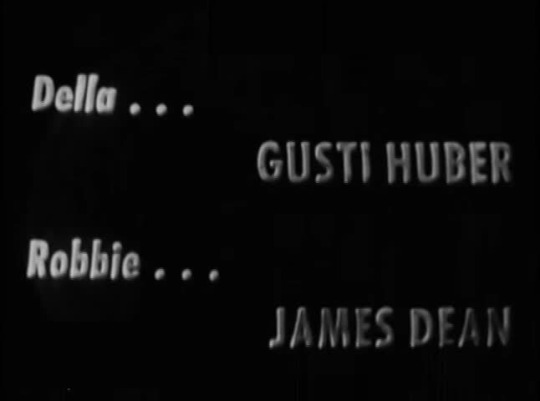
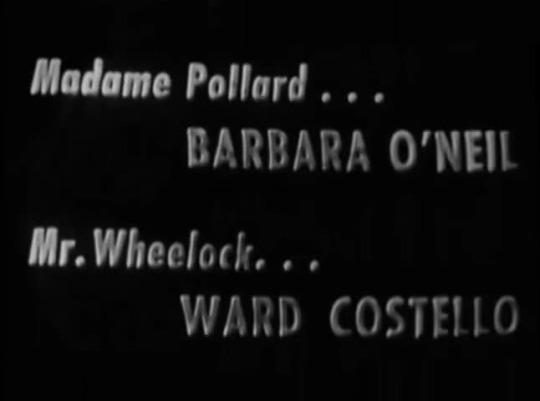
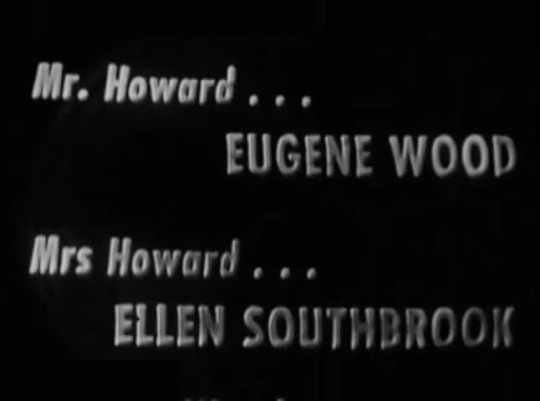
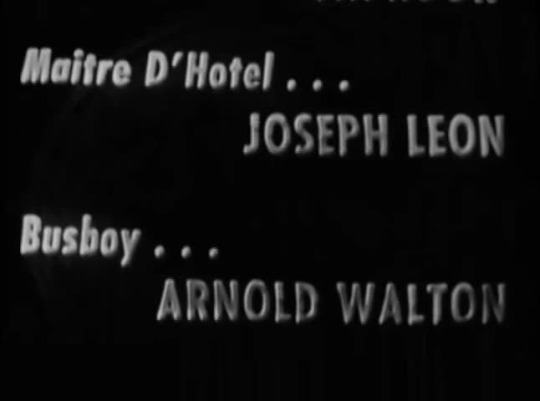
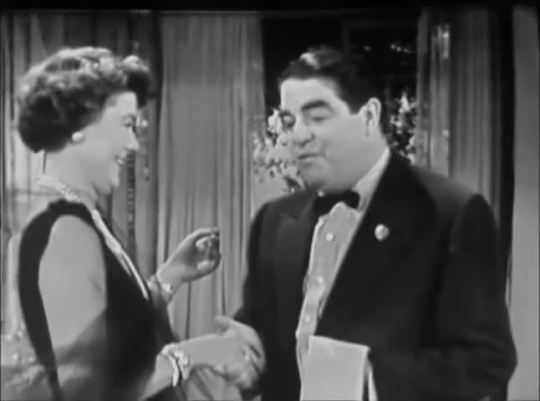
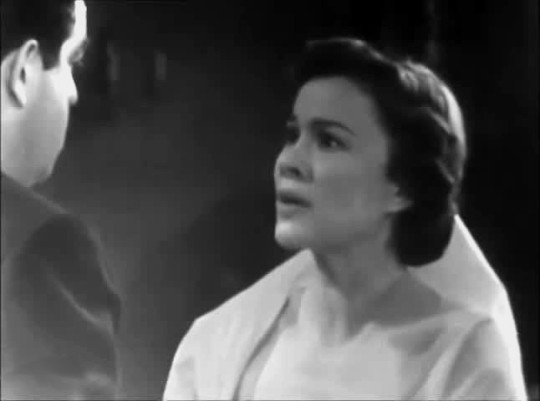
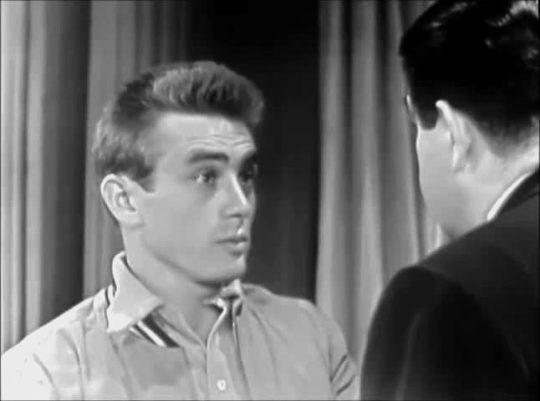
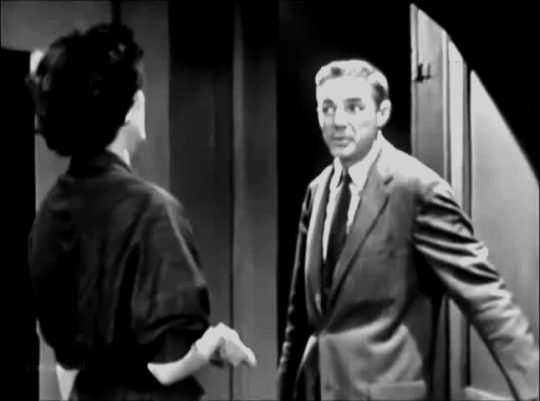
From the Golden Age of Television
Run Like a Thief - NBC - September 5, 1954
A presentation of "Philco Television Playhouse" Season 6 Episode 25
Drama
Running Time: 60 minutes
Director Jeffrey Hayden
Stars:
Kurt Kasznar as Alexander Ingles
Gusti Huber as Della Ingles
James Dean as Robbie Warren
Barbara O'Neil as Madame Pollard
Ward Costello as Investigator Robert Wheelock
Eugene Wood as Henry Howard
Ellen Southbrook as Elizabeth Howard
Joseph Leon as Charles (Maitre D)
Arnold Walton as Busboy
James Congdon as Busboy in Training (uncredited)
#Run Like A Thief#TV#Philco Television Playhouse#Drama#1954#1950's#NBC#Kurt Kasznar#Gusti Huber#James Dean#Barbara O'Neil#Ward Costello
0 notes
Text

#RudyTuesday On April 3, 1949, NBC Television Playhouse (sponsored by Philco) presented "And Never Been Kissed," a story about teenagers in the 1920s adapted from a novel published earlier that year. The production, seen here in rehearsal, was written by Samuel Taylor and directed by Fred Coe.
Coe's biography, The Man in the Shadows: Fred Coe and the Golden Age of Television by Jon Krampner, was published by Rutgers University Press in 1997. The UCLA Film and Television Archive has kinescopes of many Coe productions and has made some digital transfers. The Wisconsin Center for Film and Theater Research also has kinescopes.
One in a series of photos from the Rudy Bretz papers at UMD.
6 notes
·
View notes
Text
MILTON PARSONS
May 19, 1904

Ernest Milton Parsons was born in Gloucester, Massachusetts, in 1904. He appeared in more than 160 films and television shows between 1939 and 1978. He attended Boston University, where he participated in dramatics and me this future wife, Collette Humphrey. It was at Boston University where he also began writing, specializing in drama and journalism. Parsons appeared in four Broadway plays between 1930 and 1950, the last directed by Hume Cronyn.

He made his screen debut in 1939′s When Tomorrow Comes, playing (uncredited) Mr. Henderson, the organist. He was seen in four films with William Frawley (from 1941 to 1955), the most popular of which was 1942’s Roxie Hart starring Lucy’s pal Ginger Rogers. It was later the basis for the hit musical Chicago.

From 1948, Parsons and Lucille Ball shared something in common off screen: the community of Chatsworth, California, in the San Fernando Valley outside of Los Angeles. Around the same time the Anazes moved to Chatasworth, so did the Parsons’, who settled on Farralone Avenue in a home they wittily called “The Parsonage”. Parsons and his wife established a Chatsworth children’s theatre called the Cookie Jar Theatre. Parsons wrote and directed all their productions, even holding rehearsals (and sometimes performances) in his home. Lucille Ball and Desi Arnaz were also residents, dubbing their home on Devonshire Drive “The Desilu Ranch.” The Cookie Jar Theatre closed around 1963, by which time Lucy and Desi had left Chatsworth for Beverly Hills. Parsons and his family remained as residents for the rest of his life.

Parsons made his television debut in April 1951 with an episode of “The Philco Television Playhouse” on NBC.

His very next project for television was playing Mr. Thurlow on “I Love Lucy” in “Ricky Thinks He’s Getting Bald” (ILL S1;E34) filmed on April 25, 1952, and first aired on June 2, 1952. “I'm not only the Hair Club president but I'm also a client!”

In 1957, he returned to Desilu for a day on their hit sitcom “December Bride” guest-starring Rudy Vallee.

A year later he was back for an episode of Desilu’s “Whirlybirds”.

In January 1960, he played a hotel clerk in an episode of Desilu’s “The Untouchables” titled “The St. Louis Story.”

In April 1961, he was seen on an episode of “The Jack Benny Program” which was filmed at Desilu.

In 1962, he made a brief appearance in the film version of The Music Man. Credited as ‘Farmer,’ it was his resemblance to the man in Grant Wood’s iconic painting “America Gothic” that got him the role. Robert Preston played the title character, and would play the male lead again when the musical film of Mame was made in 1974 starring Lucille Ball. The film also featured Ralph Hart (”The Lucy Show”), Charles Lane, Mary Wickes, Jesslyn Fax, Barbara Pepper, Ray Kellogg, and Max Showalter.

In September 1964, he appeared as a mysterious caretaker on an episode of “The Dick Van Dyke Show” which was filmed by Desilu.

His final screen appearance was in the 1977 TV movie “A Love Affair: The Eleanor and Lou Gehrig Story.”
He died on May 15, 1980 at age 75.

In 2014, a short documentary of his life was created titled “The Face Is Familiar: Milton Parsons”.
#Milton Parsons#I Love Lucy#The Music Man#Untouchables#Whirlybirds#The Dick Van Dyke Show#The Jack Benny Program#December Bride#TV#Desilu#Chatsworth#Philco Television Playhouse#Cookie Jar Theatre#When Tomorrow Comes
2 notes
·
View notes
Photo







Grandma Moses 1952
"It was my good fortune to play the engrossing life of the great American artist. Both of her ancestors came over on the Mayflower." - Miss Lillian Gish Schlitz Playhouse, CBS, 1952 March 28 Photograph, IBM, courtesy Galerie St.Etienne (Dorothy and Lillian Gish by Lillian Gish) ......................... Variety March 1952:
CBS-TV’s “Schlitz Playhouse of the Stars” may not always have the lush sets and expensive properties featured on some of the other TV dramatic showcases, but for the warmth and human qualities of its presentations, it is seldom topped.
Variety review of Lillian Gish in “The Autobiography of Grandma Moses,” the nonagenarian primitive artist. “emerged as a pleasant but lackluster video entertainment as staged by CBS-TV’s Schlitz Playhouse of the Stars Friday night (March 28).
Adapted by David Shaw from Mrs. Moses’ recently-published autobiography, the play had Lillian Gish in the title role spinning tales to her grandchildren on her early life and how she won recognition with her colorful American primitives after she had passed 80. Story flashed back from camera shots of Grandma Moses paintings to the related incidents in her life, which was a clever technique. This was one spot, though, where color TV was urgently needed.
With Miss Gish etching a warmly human characterization of the nice old lady who was as eager to receive compliments for her strawberry preserves as for her life on a farm dating back to the days when Abraham Lincoln was President. Sisters Denise and Jane Alexander were competent as the artist at the ages of five and 12, respectively, and Georgianne Johnson turned in a sympathetic portrayal of Mrs. Moses at age 26. Russell Hardie was good as her husband, and Sidney Smith limned an okay role as the art connoisseur who discovered her artistic talents.
Joseph Scibetta reined both the actors and the cameras through their paces in fine style. Sets and other production mountings were standout. Durward Kirby again handled the Schlitz commercials, tying them cleverly with the sets of the play.
Jim Patterson note: Lillian liked the role and Grandma Moses. She recalled the role in interviews from the 1960s and until the end of her life. She channeled Grandma Moses for a scene where she is painting in 1987's "The Whales of August." ..............................
Anna Mary Robertson, also known as "Grandma Moses," became widely famous for her nostalgic paintings depicting rural American life. Born in 1860, artist Grandma Moses spent decades living the rural, agricultural life that she would later feature in her paintings. She only began devoting herself to art when she was in her seventies. In 1938, an art collector discovered her work. Completely self-taught, Moses soon became famous for her images of country life. She died in 1961 at the age of 101. In 1905, Moses returned to New York State with her family. She and her husband operated a farm in Eagle Bridge, New York. Moses later began dabbling in painting, creating her first work on a fireboard in her home in 1918. She occasionally painted after that, but she didn’t devote herself to her craft until much later. Moses suffered a great loss in 1927 with the death of her husband, and she sought ways to keep busy in her grief. By the mid-1930s, Moses, then in her seventies, devoted most of her time to painting. Her first big break came in 1938. She had some of her works hanging in a local store, and an art collector named Louis J. Caldor saw them and bought them all. The following year, Moses had some of her paintings shown at the Museum of Modern Art in New York in an exhibition of unknown artists. She went on to have her first one-woman show in New York as well as had her picturesque works displayed at Gimbels, a famous New York department store, the following year. Moses often drew from her memory for her captivating scenes of rural life. According to the New York Times, she once said that “I’ll get an inspiration and start painting; then I’ll forget everything, everything except how things used to be and how to paint it so people will know how we used to live.” Some of her images, such as “Applebutter Making” (1947) and “Pumpkins” (1959), brightly depict the labors involved in agricultural life. Others, such as “Joy Ride” (1953), showcase a moment of fun and play. Sometimes referred to as an American primitive artist because she was self-taught, Moses developed a devoted following. In the mid-1940s, her images were reproduced on greeting cards, which introduced her to a wider audience. Moses won the Women’s National Press Club Award for her artistic achievements in 1949. She went to Washington, D.C., to collect this honor and met with President Harry Truman during her visit. Moses soon switched from the paintbrush to the pen, writing the 1952 memoir My Life’s History.
6 notes
·
View notes
Text

Delbert Mann, January 30, 1920 - November 11, 2007.
With Sidney Poitier on the set of a 1948 episode of The Philco Television Playhouse.
15 notes
·
View notes
Text







BRUCE GORDON.
Filmography
Movie theater
1948: The Naked City
1948: The Street with No Name
1949: Canned Love
1958: The Buccaneers
1959: Curse of the Undead
1960: Mission of Danger
1960: Key Witness
1962: Rider on a Dead Horse
1962: Tower of London
1968: Slow Run
1969: Hello Down There
1971: Machismo: 40 Graves for 40 Guns
1978: Piranha
1982: Timerider: The Adventure of Lyle Swann.
TV
1951: Nash Airflyte Theater
1951-1953: Lux Video Theater
1951: The Philco Television Playhouse
1952-1955: Studio One
1952: Thriller
1953-1957: Robert Montgomery Presents
1953: The Goldbergs
1954-1955: You Are There
1954: King Richard II
1954: The Man Behind the Badge
1955-1957: Kraft Television Theater
1955: The Best of Broadway
1955: Justice
1955: Star Tonight
1955: The United States Steel Hour
1955: I Spy
1956-1957: Jane Wyman Presents The Fireside Theater
1957-1959: Have Gun - Will Travel
1957-1963: Armstrong Circle Theater
1957: The Lark
1957: The Kaiser Aluminum Hour
1957: M Squad
1957 : Decoy
1957: Harbourmaster
1957: Zane Gray Theater
1957: Tombstone Territory
1958-1959: Behind Closed Doors
1958-1959: Whirlybirds
1958-1959: Westinghouse Desilu Playhouse
1958-1960: Gunsmoke
1958: The Walter Winchell File
1958: The DuPont Show of the Month
1958: Trackdown
1958: Jefferson Drum
1958: Man Without a Gun
1958 : Target – TV series, one episode
1958: Colgate Theater
1958: Northwest Passage
1958: Shirley Temple's Storybook
1958: Sheriff of Cochise
1959-1963 : The Untouchables
1959-1964: Perry Mason
1959-1970: Bonanza
1959: The Californians
1959: Alcoa Presents: One Step Beyond
1959: The Scarface Mob
1959: Playhouse 90
1959: Johnny Ringo
1959: The Detectives Starring Robert Taylor
1959: The Grand Jury
1960-1961: Sugarfoot
1960-1962: Outlaws
1960: Riverboat
1960: Tightropes
1960: Paree's Hotel
1960: Laramie
1960: The Chevy Mystery Show
1960: 77 Sunset Strip
1960: Tales of Wells Fargo
1960: The Barbara Stanwyck Show
1960: Stagecoach West
1961: Maverick
1961 : The Deputy
1961: Checkmate
1961: Gunn
1961: Death Valley Days
1967: The Jackie Gleason Show
1967: He & She
1968: The Flying Nun
1968: Super Agent 86
1968: Mannix
1968: Gentle Ben
1968: Tarzan
1968: It Takes a Thief
1969: Blondies
1969: Ironside
1970-1972: Here's Lucy
1970-1972: Adam-12
1970-1973: The Doris Day Show
1971: The Smith Family
1972: The Partners
1974 : Banacek
1975: The Police Woman
1975: Lucy Gets Lucky
1975: Joe Forrest
1977: The Hardy Boys/Nancy Drew Mysteries
1982: The Stunt Man
1984: Simon&Simon.
Créditos: Tomado de Wikipedia
https://es.wikipedia.org/wiki/Bruce_Gordon_(actor)
2 notes
·
View notes
Text

"In every marriage more than a week old, there are grounds for divorce. The trick is to find, and continue to find, grounds for marriage."
Happy Birthday, Robert Anderson (1917-2009)
Playwright, Screenwriter. He is best known for his play "Tea and Sympathy" which had a two-year run on Broadway (1953 to 1955), and was made into a successful motion picture in 1956. He studied at the Dramatic Workshop of the New School. He began his career as a writer during the early years of television for such programs as "The Philco Television Playhouse," "Goodyear Television Playhouse" and "The United States Steel Hour." Among his other stage writing credits are "All Summer Long" (1954), "Silent Night, Lonely Night" (1959 to 1960), "You Know I Can't Hear You When the Water's Running" (1967 to 1969) and "I Never Sang for My Father," which became an Oscar-nominated 1970 film adaptation which starred Gene Hackman and Melvin Douglas. His further big screen credits include "Until They Sail" (1957), "The Nun's Story" (1959) and "The Sand Pebbles" (1966, which earned Steve McQueen an Academy Award nomination). He was formerly married to actress Teresa Wright.
1 note
·
View note
Photo

Patricia Betsy Hrunek “Betsy Palmer” November 1, 1926 East Chicago, Indiana, U.S. May 29, 2015 Danbury, Connecticut, U.S. #Marty (1953) TV The Philco-Goodyear Television Playhouse (1953-1956) TV #OneStudioinHollywood (1953-1957) TV #TheGoodyearPlayhouse (1954-1957) TV #DeathTide (1955) #The Long Gray Line (1955) #Miss Roberts (1955) #Queen Bee (1955) #Ive Got a Secret (1955-1967) TV #TheTinStar (1957) #Playhouse90 (1958) TV #TheTrueStoryofLynnStewart (1959) #TheLastAngryMan (1959) #Fridaythe13th (1980) #Fridaythe13thPartII (1981) #TheLoveBoat (1982) TV #MurderSheWrote (1985-1989) TV #CharlesinCharge (1987) TV #OutofthisWorld (1987-1988) TV #IsabelsChoice (1988) TV Movie #WindmillsoftheGods (1988) TV Movie #GoddessofLove (1988) TV Movie #KnotsLanding (1988-1990) TV #Columbo : Death Hits the Jackpot (1991) TV #StillNotQuiteHuman (1992) TV Movie #JustShootMe (1998) TV #WaltzingAnna (2006) #BellWitch : The Movie (2007) #BetsyPalmer #Horrormovies #PamelaVorhees https://www.instagram.com/p/B4Fjkfgg6o0/?igshid=mv02yl0i2dim
#marty#onestudioinhollywood#thegoodyearplayhouse#deathtide#the#miss#queen#ive#thetinstar#playhouse90#thetruestoryoflynnstewart#thelastangryman#fridaythe13th#fridaythe13thpartii#theloveboat#murdershewrote#charlesincharge#outofthisworld#isabelschoice#windmillsofthegods#goddessoflove#knotslanding#columbo#stillnotquitehuman#justshootme#waltzinganna#bellwitch#betsypalmer#horrormovies#pamelavorhees
0 notes
Photo
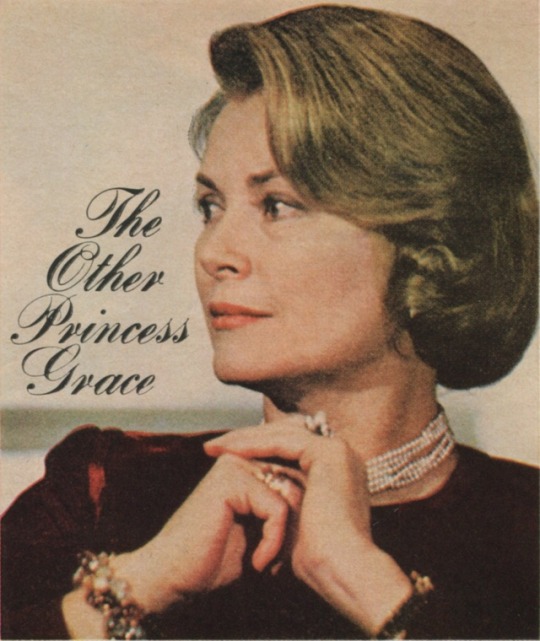
Taken from Good Housekeeping, May 1977
A noted novelist visits Princess Grace and finds laughter and tears beneath her serene armor of “glacial perfection.”
The Other Princess Grace by Budd Schulberg
When I was invited to write the scenario for a television special on the life of Princess Grace of Monaco, my gut reaction was: What an odd bit of casting. I write about prizefighters, brawny longshoremen, the fight for survival in the inner cities. I root for underdogs.
Princess Grace wasn't exactly my idea of an underdog. Her father was rich and she is immaculately beautiful. Her career from Philadelphia to New York to Hollywood to Monaco seemed to be up, up, up to the top of the mountain. For a child of Hollywood who had been raised with - and, accordingly, took a rather dim view of - movie stars, and of establishments in general (from film moguls to European royalty), a pilgrimage to the crystal chandelier world of Princess Grace Patricia Kelly Grimaldi of Monte Carlo would not seem to be my cup of tea, or should I say, my Venetian glass of champagne.
Is that a nice way to talk about a princess? A princess, especially an American born princess, is the stuff and the fluff of fairy tales. Hans Christian Andersen (with an assist from F. Scott Fitzgerald) should be writing this story instead of a follower of the fight game, a self-appointed expert on Muhammad Ali.
But it's a little late in the day for Andersen or Fitzgerald. And so...
Once upon a time there was a beautiful Irish-American girl whose grandfather had sailed as an immigrant boy in search of his fortune in the New World. If we had told John Henry Kelly as he stepped off the gangplank of a creaky old sailing ship in Boston that his granddaughter would return to the Old World and become the Princess Grace married to Rainier III and help to rule a sovereign principality from a 200-room palace that is one of the most majestic living museums in all Europe, that sturdy greenhorn would have put us in our place.
Grandfather Kelly made his way in the green world of 19th-century New England. His sons moved on to Philadelphia, where they prospered. Patrick, the oldest, made a success of the construction business and Grace's father, Jack Kelly, went to work for him as a hod-carrier and a bricklayer. A fierce second-generation competitor, Jack thrived on work. He could lay bricks fast and make money fast and row fast - somehow he found time before and after work to train for hours every day in a racing shell on the Schuylkill river and to become the national sculling champion. Wife Margaret was an ideal mate, not just a successful magazine cover girl but an athlete, too: the first co-ed physical education teacher at the University of Pennsylvania. “Way ahead of her time,” Princess Grace would reminisce, “the completely well-rounded modern woman. Now there's someone you could do a special on!”
We were sitting with her in the drawing room of the Grimaldi’s Paris townhouse in a courtyard of lovely old houses just off the Avenue Foch. When we rang the buzzer, she came to the door herself, with a warm and easy welcome to Bill Allyn, who would produce the TV special. Allyn had been a friend of hers from live television days in the early 1950's when they were both young actors scrounging around New York for work.
I was pleasantly surprised at the informality. No liveried servants, no bowing or scraping. Dressed in slacks and a light brown sweater with another shade of brown sweater over it, she might have been a suburban housewife in her late thirties, an especially pretty housewife. Marvelous eyes, marvelous nose, marvelous bones, marvelous skin. Yet neither in dress nor in manner anyone's conception of a fairy-tale princess. More like the girl next door, albeit the beautiful girl next door, 20 years later. I had pictured the cool grace of the Hitchcock movies and palace receptions. Instead, in a most friendly manner she led us into the drawing room, tastefully furnished but lived-in and warm. A big old dog called Andy bounded at her side. Chatting and reminiscing with Bill, she was shy and diffident with me, a watchful stranger. But quicker to laugh than I would have expected.
Spread on the coffee table were snapshots of a recent family trip to the Sahara. "I'm the family photographer," she said. "I really think these are pretty good, don't you?"
She picked one out, a moody sandscape relieved in the distance by what looked like an oblong glass. A mirage, she said proudly. "That's awfully hard to get. Rainier didn’t seem so impressed. But even when you can see it with the naked eye, it's tricky to pick up with a camera."
We asked about her family, the Philadelphia Kellys. Jack Kelly Sr. had been a driving spirit whose motto in life was, "I don't care what you do but whatever it is, don't just be good at it, be the best!"
He had gone to England's Henley Regatta to race in the Diamond Sculls, but had been forbidden to enter because he had the hands of a working man. "This is an event for gentlemen." A generation later, the Kelly family had gone to England to cheer Grace's brother "Kell" on as he won the cup that had been denied his father.
"There aren't any words that can do justice to my feelings." Father Kelly had said. "I feel a tremendous sense of pride for Kell. He's the one that matters, not the thwarted ambitions of an old guy who once got his fingers publicly burned over here because he was born without a silver spoon in his mouth."
"It must have been a heavy load," I said to Princess Grace, "to keep up with the Kellys, to keep up with yourself - to be the best."
She crossed her legs and thought a moment, as if there were still a challenge in the question, some lingering sense of childhood hurt. We had heard from friends that not only had she been a shy child, but rather sickly, too - unlike her outgoing, tomboyish older and younger sisters. She liked to stay in her room and read, draw, sew and dream, try to turn her introspection into poetry.
"Yes, it was - it is - a heavy load," Princess Grace said. The silence that followed seemed to hold its own inaudible sentences: Loads are to be carried. Burdens are to be borne. Challenges are to be met. And overcome. You could almost hear the convent sisters teaching her character with a stinging ruler. And the voice of Jack Kelly Sr. echoed in the room: "Be the best, Grace Patricia, be the best!"
UNCLE WON PULITZER
The mood changed suddenly when we talked of her two theatrical uncles: Walter Kelly toured the vaudeville stages of the world as "The Virginia Judge," and the famous playwright of the 1920's, George Kelly, won the Pulitzer Prize for Craig's Wife. Grace warmed to his memory. "I think Uncle George was a great American playwright, but there's a whole new generation that doesn't know him as well as I wish they did. He knew his people. Exactly how they talked and what they felt. Both The Torchbearers and The Show-Off are wonderful plays, human, funny and moving. In his preface to The Show-Off, the great humorist Heywood Broun wrote, ‘This is the best comedy yet written by an American.’”
Then it was Uncle George who influenced you to go into the theater?" She thought a moment.
"We were always doing plays. I was Cinderella in my sister Peggy's play when I was twelve, and I had a part in an Old Academy Players production in our hometown, called Don't Feed the Animals. I did Peter Pan as our graduation play at Stevens - but we were talking about Uncle George."
Clearly, of the two theatrical careers, she was much more at ease with George's than Grace's. "Uncle George was one of the most fascinating men I ever met. He could remember every poem he ever read. He loved poetry and language and the theater. He could recite favorite poems all night long. So wise, witty, human - there was simply no one like him in the whole world."
I had once been aware of, and then half-forgotten, the George Kelly-Grace Kelly family relationship. Certainly I hadn't realized until now what a driving force it has been in her life.
Then, with both of them remembering lines from another of Uncle George's plays, Behold, the Bridegroom, Bill Allyn and Grace (for she was all actress now and not at all princess) fell to reminiscing about those live shows they had done in what is now looked back on nostalgically as "the Golden Age of television": Studio One, Lights Out, Philco, The Kraft Playhouse. They were both talking at once. "Those were really insane days... absolutely hysterical... things are so much more ordered now, on film or tape, but live, going on in front of all those viewers... how did we ever get through it?"
"It was like living on the edge of a precipice!" Grace was laughing. "I'll never forget one time I was playing a scene in bed with all my clothes on under the covers so I'd be ready to run into the next scene dressed. But the camera didn't stop in time and they didn't cut away, so there I was, on the screen getting out of bed with all my clothes on!"
Now she and Bill were trading bloopers. She was up on her feet, standing in front of the mantel, trying to stop from laughing so she could demonstrate a dreadful mishap in The Cricket On The Hearth. "It was supposed to be snowing and a wonderful English character man and I were coming to bring an orphanage a hot pie for Christmas. The prop men were throwing salt down but we were told to walk close to the window under the eaves, so it wouldn't actually fall on us, because there we'd be with snow on our costumes that wouldn't melt when we got inside. We were to wave through the window, and the pie was too hot. So I set it down and the old actor stepped in it. He came limping into the place with half the pie spread over his shoe. "Look what we brought you - this nice, hot pie - Merry Christmas!"
INFECTIOUS LAUGHTER
As I listened to her laugh, I thought of all the people who had warned me about her "glacial perfection." But the laughter was infectious - from a real live girl with an appealing, self-deprecating sense of humor.
She was still getting money from home in those early theatrical days, but that streak of independence led her into modeling to pay for the acting classes. Before she was 19, she was earning enough to move out of the Barbizon Hotel for women and into her own apartment. A nesting sort of person, she enjoyed fixing up the place.
"Remember giggle belly?" Allyn said.
"Giggle belly!" Again Grace laughed as she tried to describe this silly game. A group of young actors would lie on the floor with their heads on each other's stomachs and tell funny stories that would make their heads bounce up and down as their bellies giggled. "We did a lot of silly things," they both agreed. "And we all laughed a lot. But along with the fun there was hard work... "
"Like Strindberg's The Father," we prompted.
That was Grace's Broadway debut, with her name in small print under the starred names of Raymond Massey and Mady Christians. Grace still says she only got the role because both stars were tall and her rivals for the part were all too short. "Nonsense,” says Raymond Massey. "She got the part because she showed the most promise. All through the rehearsal period we were impressed with her earnestness, her professionalism and her good manners. She was organized and dedicated. Between rehearsals she would ask Mady if she could sit in her dressing room and talk about the theater. She was a delight to have in the company. A rare kind of young person who had a hunger to learn and to improve herself."
"It ran only a short time," Grace said, "but it was wonderful experience."
Young Grace Kelly soon became a favorite cover girl, so it was inevitable that Hollywood would tap her on the shoulder - Hollywood personified in the ebullient, English-fracturing Russian director, Gregory Ratoff, who screen tested her for a somewhat less than immortal film entitled Taxi.
The Taxi story turns out to be another funny bit. I'm not studying her anymore, I'm laughing with her. It has ceased being a job and has become a vacation.
The role in Taxi, she told us, called for an Irish brogue. Although her name was Kelly, she sounded not at all like forebears from County Mayo. More like a proper Philadelphian. But, like any aspiring actress, she assured Mr. Ratoff that the brogue was no problem. Then she ran home to ask how one went about acquiring an overnight brogue.
"One of my friends had a maid just ονer from Ireland I hurried oνer to listen to her speak. But she was too shy to open her mouth. I'd ask questions to try and get her talking, and all she'd say was, ‘Yes, Mum,’ or ‘No, Mum.’ So I handed her the newspaper and asked if she'd mind reading it out loud. The poor girl finally admitted that she could hardly read. I put together what thought might pass for a brogue - and flunked the screen test."
But Grace Kelly had what Frances Fuller, head of the American Academy, described as, "A very special quality. Also the face of a Grecian goddess, but it was that extra something that is more than beauty, some special poise, an inner light."
When her New York agent, Edith Van Cleve, described that "special quality" to Jay Kanter, a youthful but influential Hollywood agent, brogue or no brogue, Kelly was movie bound.
AGAIN THE PRINCESS
"You must be getting hungry?" was Grace's answer to the first question about Hollywood. “If it's alright with you, I've made a reservation at a club nearby - the food is quite good." She rose briskly. Suddenly she seemed the princess - a gracious, down-to-earth princess, but clearly in command. Now it was difficult to imagine her ever playing "giggle belly" or impersonating an old actor with a meat pie on his shoe.
A blonde, middle-aged, bejeweled houseguest materialized. A friend from Grace's Philadelphia days. Having lived at least four different lives in four different times, places and worlds, Grace cultivates a capacity for not losing touch with anyone of them.
There was a waiting chauffeur and limousine. The princess asked us if we'd prefer to walk. The gentlest of commands. People who recognized her pretended not to, as if they understood that she preferred it that way.
We were ushered to a round table in a corner of the Club Rothschild with the most muted of fanfare. Luncheon conversation was easy but disjointed because Grace's houseguest was something of a dangling participle to a life story I was trying to piece together. It was like a flashback to Philadelphia adolescence while I waited to move forward to Hollywood early maturity. The princess was being the perfect hostess, somehow managing to talk old times with her hometown friend and films and filmmakers with us. On her way out, I noticed that fellow members of the club stepped back or moνed to one side so they could gain a clear view without being ostentatious. She pretended not to notice.
Back in the comfortable and now familiar drawing room, we were returning to the Hollywood of my youth. After an uneventual role in a forgotten movie called Fourteen Hours, Grace was on her way to the most remarkable five-year career in the history of motion pictures. A mouthful of a statement, but there it is. In 60 months, a classically photogenic face, the stamina of a marathon runner, an obsessive drive for self-improvement and a little bit of luck that was parlayed into great gobs of luck by the power of the will, swept Grace Kelly from obscure starlet to international star.
The luck began when Jay Kanter "sold" her to producer Stanley Kramer and director Fred Zinnemann for High Noon. In her big scene, she is finally driven to pick up a rifle and kill the fourth outlaw to save her husband, played by Gary Cooper, after Cooper has dispatched the other three.
A nomination for Best Supporting Actress in Mogambo didn't convince her that she was all that good in it. "I really wasn't," she said straightforwardly. "I was lucky. I was in awfully good hands. I was new in the business."
To master film technique, so different from either live television or the theater, was a challenge. "Be the best!" was echoing in the hall again. But from the outset Grace Kelly was a different cut from the lovely blonde starlets so overjoyed and overwhelmed by Hollywood. With her two sisters to keep her company, she stayed at that Sunset Boulevard relic of lost elegance, the Chateau Marmont. She would only sign her seven-year contract at MGM with the provision that she could go back to New York and the theater every other year. Remembering her as a star on the rise 25 years ago, agents, producers, directors, fellow actors and friends all draw a consistent picture of a girl with a steel trap mind who could not be dissuaded once she set that mind on what she wanted to do.
LUCK AND WILL
Now the Kelly luck embraced the Kelly will: the screen test that had failed her in her quest for a role in Taxi impressed that crustiest of critics, John Ford, who cast her in Mogambo - a remake of Red Dust, with Grace playing the Mary Astor role of the genteel but adulterous wife, Ava Gardner taking on Jean Harlow's "Honey Bear" and Clark Gable repeating the role he had created in the original. Two more disparate ladies than Ms. Kelly and Ms. Gardner could hardly be imagined, but they got on surprisingly well. Ava threw tantrums while Grace tended to her lines and her knitting. Frank Sinatra, in Africa for a visit with his unpredictable Ava, pronounced Grace Kelly the squarest of the squares. Even when columnists hinted out loud that Graces love scenes with Gable were unusually convincing. Grace never lost her Kelly cool.
Back in Hollywood for the Mogambo interiors. Grace and fellow-actress Rita Gam found an unpretentious apartment on Sweetzer Avenue. A pair of hard working bachelor girls, they were an odd couple: the cool golden girl who all ways seemed to have her emotions in check and the dark, exotic beauty whose emotions kept spilling over, "We both kept falling in love with the wrong men,” Rita remembers.
But if there were emotional frustrations and dead ends, the Kelly career kept climbing smoothly upward. The same, now-famous test that Ratoff and 20th Century-Fox had thumbed down caught the eye of another film master, Alfred Hitchcock. There was Dial M for Murder opposite Ray Milland, Rear Window opposite Jimmy Stewart and To Catch A Thief vis-a-vis Cary Grant.
With top directors Zinnemann, Ford and Hitchcock and leading men Cooper Gable and Grant, could a girl ask for anything more? If her name is Grace Kelly, the answer is yes.
We were still sitting in the Paris townhouse, but our minds were now focused on The Country Girl. The Clifford Odets Broadway hit was to be done as a film Every female star in town was after the role of the drunken actor's wife, described by Odets as "the broom behind the door." Grace knew that this was a part that could prove she wasn't just an elegant clotheshorse.
But winning that role was one of the longer shots in the Hollywood sweepstakes. In the first place, MGM, her "home studio," didn't want to loan her out. In the second place, Paramount and the producers of The Country Girl - wanted a bigger name to match the star male leads, William Holden and Bing Crosby. And, finally, even Crosby, looking for all the help he could get in playing a complex and difficult dramatic role, expressed his doubts that the elegant Kelly girl could handle a part so totally out of character for her.
The more opposition, the greater the determination. Grace told Jay Kanter and Lew Wasserman, representing the sinew and brains of the powerful agency that represented her, that they had to get Metro to release her for the role. She had to get this part. Otherwise, she was ready to go on suspension, quit Hollywood and return to New York to concentrate on the theater.
Thus are Hollywood legends born. For the screen test, Edith Head, whose mantelpiece is a parade ground for Best Costume Oscars, and who had dressed Grace in dazzling gowns for those high fashion movies, now helped Grace completely transform herself into the worn and weary country girl. And in the film, which she subsequently made, it wasn't just an outward change. She gave a performance from the inside such as she had never given before. At the end of the first week, a convinced Bing Crosby said, "I'll never open my big mouth again!"
It was Oscar time and Grace was nominated for Best Actress. But everybody agreed that Judy Garland had a lock on the little statue - the sentimental favorite making a dramatic comeback (on and of the screen) in the musical remake of A Star Is Born. But when Bill Holden opened the envelope on the stage of the Pantages Theater, we heard: "And the winner is . . . Grace Kelly!"
That same night Marlon Brando won his Oscar for On The Waterfront. While they posed together, swarming photographers shouted, "Kiss Marlon, Grace! Go ahead, kiss him!”
Suddenly Miss Kelly was from Philadelphia and the Stevens School, and her father was Jack Kelly, Sr. and her uncle was George Kelly, who had won a prize she respected perhaps even more, the Pulitzer. "Don't you think he should kiss me?” asked Grace Patricia, looking cool and elegant in aquamarine satin. On she swept to a party at Romanoff's - the girl who had everything. "Miss Perfect," people were calling her, some in awe and some inspite
"How did it feel?” I asked her in Paris.
Another long pause. "I was unhappy. Now I had fame, but you find that fame is awfully empty if you don't have someone to share it with."
As she sat there remembering that triumphant and lonely night, I found myself thinking of a note that F. Scott Fitzgerald had written to himself while preparing to write his heroine Kathleen in The Last Tycoon: "People simply do not identify with people who have all the breaks. I must endow this girl with a little misfortune.” I was beginning to find it in the girl who had everything.
Meanwhile, back at the Palace...
In 1955, the principality of Monaco was not the flourishing place it is today. The casino was run-down, the ancient palace itself in disrepair. Aristotle Onassis, George Schlee and Gardner Cowles were meeting to discuss how to save it.
Running the troubled affairs of Monaco for seven years, already in his mid-30's and still a bachelor, Prince Rainier III knew he must find a suitable wife with whom to share his life and the duties of the principality. Remembering his own unhappy childhood (a broken home at age six, lonely and disoriented at a British boarding school), Rainier insisted he would not make a marriage of convenience.
LOVE STORY OF THE CENTURY
And so the stage is set for what the press of the world called, "The love story of the century." The Prince had met Grace casually in Monaco when she attended a showing of To Catch A Thief the year before. Now he came to Hollywood on a visit less casual. Then went on to Philadelphia to meet her family.
I begin to ask direct questions and get surprisingly (although less surprised now than when I first met her) direct answers.
"Did you ask your parents for permission to marry Rainier?"
"No, I made up my own mind. I had asked them once or twice before and it hadn't worked out. This time I knew I had to make my own decision."
In fact, Father Kelly disapproved of the match. Rainier seemed like a nice fellow. But European princes are notorious playboys. And she'd be an American living far away in a foreign land.
I took a breath. “Princess Grace, do you mind if I ask you a very personal question?"
"Well, suppose not."
"I'm trying to put myself in your place. Every writer has to do that. It must have been a terribly difficult moment. You were marrying a man you barely knew… going off to a strange world… knowing as a member of your church there was no turning back. Giving up a film career on your way to becoming a superstar - you must have felt... well, how did you feel as you went up that gangplank?"
This time the pause was so long that I thought she resented my question too much to answer. She stared at the floor. When she looked up, her eyes were wet. If she had glacial perfection, the glacier was melting. She spoke quietly, with total simplicity:
"The day we left, our ship was surrounded in fog. And that's the way I felt - as if I were sailing off into the unknown. I had been through several unhappy romances. And although I had become a star, I was feeling lost and confused. I didn't want to drift into my thirties without knowing where I was going in my personal life."
As if she had been conceived by Scott Fitzgerald, here she was, endowed with a certain misfortune.
"I guess I'm a homebody at heart, she was saying. But I didn't have a home. Rainier came into my life at just the right moment. I needed someone who wouldn't be Mr. Grace Kelly. I could see that Rainier was a dedicated man. He had liberal ideas for making the principality more than a playground. While life on board ship must have seemed to the world like one continuous party, I couldn't help looking out into the fog and wondering: ‘What is going to happen to me? What will this new life be like?’ I had never met his family, except for his father, I must say he was wonderfully supportive. But I had no idea how the rest of the family, and the Court, would accept me. What sort of world was waiting for me on the other side of that fog?"
A friend said to Princess Grace, "But it was such a gorgeous wedding. The loveliest royal wedding of the century. European royalty. World celebrities. And so beautifully organized."
Now Princess Grace laughed.
WEDDING SHEER CHAOS
"Chaos! Fifteen hundred invited guests. And most of them wanting extra tickets for the balls and the dinners and the two weddings, first the civil one in the throne room of the palace, then the religious one in the cathedral. The weather was foul. And more journalists than they had covering D-Day. The language barriers! And the palace wasn't ready to be lived in yet. Sheer chaos!"
Bridesmaids, including Rita Gam, remember it as the most romantic time of their lives. But for Princess Grace the summer was long and hot. There was resentment from the traditionalists. What was an American, and from Hollywood at that, doing in their palace? Rainier understood the difficulty of the transition and was of great help to her But there were times, Grace admits, when she would stroll the palace walkway and wonder....
But time is a patient teacher. "Once Caroline was born, and then Albert, I began to feel my roots in Monaco. I was finally beginning to master the language, by osmosis. You might say I worked from the inside out. Now that I had my new family around me, I could move outside the palace into the community."
Once she got her bearings, Grace of Monaco became the most active princess the principality has ever had. Realizing that the local hospital was run down, she found ways to modernize it. She founded a daycare center and enlarged the old people's home. "She brought us heart," an old man says.
"She brought the palace back to life," says a staff member. "Inviting the children of the village into the throne room for a Christmas party. And the flowers everywhere. The Garden Club that grew into an International Flower Arranging Festival. The Children’s Village she set up through the Monegasque Red Cross to help keep together children of the same family who have lost their parents. Bazaars promoting the arts and crafts of Monaco. Using the courtyard of the palace as a natural stage for the International Arts Festival."
I was standing in the courtyard of this ancient castle, with its gracefully winding stairway. The chief of the secretariat was speaking with an enthusiasm he had drawn from Princess Grace. "She wants the palace to be used, to be alive, to help make the world more beautiful. Nureyev has danced here, and Danny Kaye has entertained, and the Paris Opera Ballet, Yehudi Menuhin, the Mexican Ballet Folklórico... She's brought a special quality to the palace that enriches the life of the principality. That's why we love to work with her. She gets up early and never stops.
"It's not just because she's our princess,” says Paul Choisit, the former consul for Monaco in New York, who now runs the secretariat, "I think she's the most unusual person I've ever known And with all the demands on her, the official duties, she still manages to save a great deal of time to share with her children. It's a known fact throughout the principality that Caroline, Albert and Stephanie are blessed with a supporting and loving mother."
I'm back at the townhouse in Paris, having returned from the old-world new-day atmosphere of the palace. We're talking of the ballet school I’ve toured (where teenage ballerinas are schooled by masters), through which Grace of Monaco hopes to restore to its former grandeur the Ballet Russe de Monte Carlo. The phone rings and it's Arthur Rubinstein. The phone rings again. It's Moscow. The International Television Festival is coming up and her staff has been at work on it, reaching out to renowned guest artists to appear at the gala after the awards. Monaco's Festival, far purer than the now corrupted Film Festival in Cannes, gives awards for such shows as the best on protection of the environment and best children's program, as judged by children themselves.
I see that Grace Kelly of Philadelphia, daughter of self-made millionaire Jack, niece of the Fabulous Uncle George, has found her way through the fog to a creative world she has made for herself on the other side.
As Hans Christian Andersen might have said, "And so the princess lived happily - and busily - ever after."
37 notes
·
View notes
Photo

Delbert Mann directing Burt Lancaster and Rita Hayworth in Separate Tables (1958). Delbert was born in Lawrence, Kansas and won an Oscar for directing Marty (1955) which he first directed on tv in 1953 as one of 75 episodes he directed of Philco-Goodyear Television Playhouse 1949-55 . Delbert had 66 credits, from a 1949 tv episode through a 1994 tv movie. From 1968 he worked almost exclusively in tv movies, with only a rare feature. None of his other work is worth mentioning.
5 notes
·
View notes
Photo

Character Actress
Nancy Kelly (March 25, 1921 – January 2, 1995) Actress in film, theater and television. A child actress and model, she was a repertory cast member of CBS Radio's The March of Time and appeared in several films in the late 1920s. She became a leading lady upon returning to the screen in the late 1930s, while still in her teens, and made two dozen movies between 1938 and 1946. As an adult, Nancy Kelly was a leading lady in 27 movies in the 1930s and '40′s.
She also starred on television, including leading roles in "The Storm" (1961) episode of Thriller and "The Lonely Hours" (1963) episode of The Alfred Hitchcock Hour. In 1957 she was nominated at the 9th Primetime Emmy Awards for an Emmy Award for Best Single Performance by an Actress for the episode "The Pilot" in Studio One.
Her other television credits include:
The Silver Theatre
The Bigelow Theatre
Faith Baldwin Romance Theatre
Lux Video Theatre
Medallion Theatre
Suspense
Ponds Theater
The Philco Television Playhouse
The Kaiser Aluminum Hour
Playhouse 90
Climax!
Suspicion
Alcoa Theatre
Sam Benedict
Medical Center
Bronk
5 notes
·
View notes
Photo




James Byron Dean (* 8. Februar 1931 in Marion, Indiana; † 30. September 1955 in der Nähe von Cholame, Kalifornien) war ein US-amerikanischer Theater- und Filmschauspieler. Sein früher Tod bei einem Autounfall und seine Rolle in … denn sie wissen nicht, was sie tun machten ihn zu einem Jugendidol. Für seine Rollen in Jenseits von Eden und Giganten erhielt er postum zwei Oscarnominierungen als Bester Hauptdarsteller.
Natalie Wood and James Dean in the trailer for the film Rebel Without a Cause
Dean hatte von Regisseur Elia Kazan eine Hauptrolle in seinem neuesten Film Jenseits von Eden angeboten bekommen. Er kannte Dean von seiner Zeit am Actors Studio und hatte ihn in The Immoralist gesehen.
„James Dean sah genauso aus wie Cal Trask in 'Jenseits von Eden', und er sprach auch so. Als er das New Yorker Büro der Warner Bros. betrat, wusste ich sofort, dass ich den richtigen Mann für die Rolle gefunden hatte. Er war vorsichtig, störrisch und misstrauisch und schien voller unterdrückter Gefühle.“, so Kazan. Zwar hatte das Filmstudio Warner Brothers seinem Regisseur noch keine Genehmigung für die Dreharbeiten gegeben, doch Dean war selbstverständlich angetan von der Idee, die Hauptrolle in einem Hollywood-Streifen zu übernehmen, und er absolvierte am 17. Februar 1954 seinen Part als Herakles’ Sohn Hyllos in dem Sophokles-Stück Die Trachinierinnen an der Seite von Anne Jackson und Eli Wallach an der New School for Social Research in Manhattan, sowie am 23. Februar seinen letzten Auftritt in The Immoralist.
Am 8. März 1954 flog James Dean gemeinsam mit Elia Kazan von New York nach Los Angeles. Zwei Tage zuvor war offiziell bekanntgegeben worden, dass Dean die Hauptrolle in Kazans neuestem Film erhalten würde. Kazan war zu dieser Zeit der gefragteste Regisseur im Theater- und Filmgeschäft und hatte 1948 den Oscar als bester Regisseur für Tabu der Gerechten erhalten. Dean führte die Habseligkeiten, die er benötigte, in zwei verschnürten Papiertüten mit sich. In Los Angeles angekommen, besuchte James Dean gemeinsam mit Elia Kazan seinen Vater an seiner Arbeitsstelle im Krankenhaus. Kazan schrieb später: „Die starke Spannung zwischen den beiden war offensichtlich, und es war keine produktive Spannung. Ich hatte das Gefühl, dass der Vater den Sohn nicht mochte.“
Genau dieses Leitmotiv durchzog auch Elia Kazans geplantes Drama Jenseits von Eden. Die Verfilmung basiert auf dem gleichnamigen Roman von John Steinbeck, mit dem Kazan befreundet war. Beide hatten gemeinsam an dem Originaldrehbuch zu Viva Zapata (1952) gearbeitet. Jenseits von Eden spielt in Salinas, Kalifornien, um die Zeit des Ersten Weltkrieges. Der Titel der Romanvorlage geht auf ein Zitat aus dem Alten Testament zurück. Der Film handelt von den beiden Zwillingsbrüdern Cal und Aron, die von ihrem puritanischen Vater Adam Trask streng nach der Bibel erzogen werden. Während Aron, brav und folgsam, in der Gunst des Vaters steht, gibt sich Cal grüblerisch und schwierig. Als der Vater bei einer Spekulation fast sein gesamtes Vermögen verliert, hofft Cal vergeblich, seine Liebe und Anerkennung mit einem großzügigen Geldgeschenk zu gewinnen, doch er wird wie schon oft in seinem Leben vom Vater zurückgestoßen. Aus Rache eröffnet Cal seinem Bruder Aron die Wahrheit über die totgeglaubte Mutter, die ein gutgehendes Bordell in der Stadt betreibt. Aron bricht zusammen, betrinkt sich und meldet sich freiwillig für den Kriegsdienst. Die Nachricht über Arons Schicksal ist für den Vater zu viel, und er bricht mit einem Schlaganfall zusammen. Das Drehbuch von Paul Osborn basiert nur auf den letzten beiden Kapiteln von Steinbecks Roman.
Um im Film wie ein gesunder Bauernjunge zu wirken und nicht wie ein blasser Stadtmensch, riet Kazan seinem Hauptdarsteller, sich eine Woche lang etwas Bräune in der Wüste zu holen, was Dean auch tat. Für Jenseits von Eden erhielt James Dean tausend Dollar in der Woche; er unterschrieb am 7. April 1954 seinen Vertrag mit dem Filmunternehmen Warner Brothers. Vertreten wurde er von Dick Clayton, der Deans Interessen an der Westküste wahrnehmen sollte, wie seine Agentin in New York ihm geraten hatte. Von dem Geld kaufte er sich seinen ersten Rennwagen, einen roten MG, Baujahr 1954. Zum Schauspielensemble stieß später Richard Davalos hinzu, der Paul Newman die Rolle des Aron wegschnappte. Die weibliche Hauptrolle der Abra, die zwischen den beiden Brüdern steht, wurde mit Julie Harris besetzt. Sie hatte sich beim Casting unter anderem gegen Joanne Woodward durchgesetzt, die spätere Ehefrau von Paul Newman. In die Rolle des strengen Vaters schlüpfte Raymond Massey.
Die Dreharbeiten begannen am 22. Mai 1954 in Mendocino, Monterey. Die Filmcrew war fünf Kilometer entfernt in einer Herberge des Dorfes Little River untergebracht. Zu Beginn der Dreharbeiten kam es zu einem Zwischenfall, als James Dean mit der giftigen Pflanze Giftsumach in Berührung kam und an einer Hautentzündung laborierte. Er wurde von der Wirtin der Herberge gesundgepflegt.
Die Dreharbeiten zu Jenseits von Eden gestalteten sich schwierig, da Dean, während die Produktion auf das Studiogelände der Warner Brothers in Burbank verlegt wurde, nicht auf Besuche der Partyszene Hollywoods verzichten wollte. Elia Kazan quartierte James Dean daraufhin in einen Bungalow direkt gegenüber von seinem eigenen auf dem Studiogelände der Warner Brothers ein, damit er ein Auge auf seinen Hauptdarsteller haben konnte, wie er 1988 in seiner Autobiografie A Life bekannte. Dean manipulierte außerdem seinen Filmvater Raymond Massey abseits der Filmkamera, indem er ihn immer wieder provozierte, damit Massey seinen Zorn gegenüber Dean nicht nur spielte und so in seiner Rolle noch überzeugender wirkte. Massey störte sich außerdem am Improvisationstalent Deans, der die Texte aus dem Drehbuch häufig nicht auswendig konnte. Obwohl Elia Kazan mit dem Gedanken gespielt hatte, Marlon Brando (für den James Dean schwärmte) und Montgomery Clift als ungleiche Brüder zu besetzen, war John Steinbeck, mit dem Kazan während der Dreharbeiten regelmäßig korrespondierte, angetan von James Dean in der Hauptrolle, und der Film war am 9. August 1954, nach zehnwöchiger Drehzeit im Kasten.
In dieser Zeit wurde James Dean von Warner Brothers zur männlichen Kultfigur stilisiert, um den finanziellen Erfolg des Films zu sichern. Dean wurde mit der attraktiven Schauspielerin Pier Angeli zusammengebracht, die ebenso wie Dean gerade zum Hollywoodstar aufgebaut wurde und zu diesem Zeitpunkt den Film Der silberne Kelchmit Paul Newman abgedreht hatte. Die Kampagne war erfolgreich, und Dean und Angeli wurden von den Gazetten bald als Traumpaar Hollywoods gehandelt. Tatsächlich kamen sich beide auch privat näher.
Nach den Dreharbeiten flog James Dean wieder nach New York, wo er in einer Episode der Serie Philco Television Playhouse spielte. Als er zwei Wochen später nach Los Angeles zurückkehrte, zerbrach langsam die Beziehung zu Pier Angeli, deren Mutter den Umgang mit James Dean nicht tolerierte. Dean zeigte sich weiterhin in der Öffentlichkeit mit attraktiven Starlets, darunter Ursula Andress und Terry Moore. Dean und Angeli traten zum letzten Mal gemeinsam als Paar bei der Premiere zu dem Film Ein neuer Stern am Himmel auf. Pier Angeli heiratete am 24. November 1954 den Popsänger Vic Damone.
Während Jenseits von Eden sich noch im Schnitt befand, weigerte sich das Filmstudio Warner Brothers, James Dean für die MGM-Produktion Die Verlorenenauszuleihen. Dean nahm zwischenzeitlich wieder mehrere Fernsehrollen an, darunter im Film Padlocks, einer Episode des CBS-Programms Danger mit Mildred Dunnockund der Episode I’m a Fool des General Electric Theatre, in der er an der Seite von Natalie Wood einen armen Bauernjungen spielt, der vorgibt, reich zu sein. Nebenbei nahm Dean Schauspielunterricht bei Jeff Corey.
Am 12. Dezember 1954 war Dean noch einmal im Fernsehen in einer Episode der Serie General Electric Theatre zu sehen, bevor er das Weihnachtsfest bei seinem Onkel und seiner Tante in Fairmount und einigen Freunden in New York verbrachte. James Dean hatte trotz einer gemieteten Wohnung in den Hügeln von West Hollywood seine alte Wohnung in New York nicht aufgegeben. Währenddessen wurde der Kinostart von Jenseits von Eden auf den Mai 1955 festgelegt.
Am 29. Dezember wurde James Dean von dem befreundeten Fotografen Roy Schatt für Life, die damals größte Illustrierte der Vereinigten Staaten, fotografiert. Die Bilder, auf denen Dean unrasiert in einem Pullover posiert, wurden jedoch von Life als zu frech bewertet und nicht veröffentlicht. Nachdem Dean in The Thief aus der Serie The U.S. Steel Hour mitwirkte, wurde er zurück nach Los Angeles gerufen. Während die Werbemaschinerie für Jenseits von Eden lief und Dean mehrfach in Zeitschriften Erwähnung als kommender Star des Jahres fand, wurde er vom Fotografen Dennis Stock begleitet, der eine Bildreportage mit dem zukünftigen Star wieder für die Illustrierte Life plante. Stock begleitete Dean zwei Wochen lang in Los Angeles; in der ersten Februarwoche 1955 reisten sie auf die Farm von Deans Verwandten nach Fairmount. Dennis Stock nahm James Dean an verschiedenen Schauplätzen seines bisherigen Lebens auf – auf der Farm, wo er aufgewachsen war, in der Stadt oder auf der Bühne seiner High School, wo er auch den Valentinstag als Ehrengast verbrachte und an den Congas der George Columbus Combo spielte. Allgemeine Misstöne gab es, als Dean sich im Beerdigungsinstitut Hunt’s in einem Sarg fotografieren ließ. Danach reiste Dean mit dem Fotografen nach New York, wo er unter anderem auf dem Times Square, in seiner Wohnung und hinter der Bühne mit Geraldine Page abgelichtet wurde. Dean gab außerdem Howard Thompson von der New York Times ein Interview in der Wohnung seiner Agentin. Die Bilder von Dennis Stock wurden am 7. Mai 1955 von Life veröffentlicht.
Am 9. März 1955 fand die Premiere von Jenseits von Eden statt, der Dean allerdings nicht beiwohnte. Er feierte den Erfolg, indem er seinen ersten Porsche kaufte, einen Porsche 356 1600 Speedster (Fahrgestellnr. 82621), mit dem er am 26. März 1955 an den zweitägigen Straßenrennen von Palm Springs Kalifornien, teilnahm. Dean gewann mit seinem Porsche das Qualifikationsrennen und trat im Finale gegen Veteranen wie Ken Miles und Cy Yedor an, die beide MG Specials fuhren. James Dean beendete das Rennen als Dritter, wurde aber später auf Platz zwei gesetzt, nachdem Miles wegen einer technischen Regelwidrigkeit an seinem Wagen disqualifiziert wurde.
Im selben Monat begannen die Dreharbeiten zu … denn sie wissen nicht, was sie tun, nachdem Dean kurz zuvor eine Hauptrolle in George Stevens Giganten erhalten hatte, die Dreharbeiten jedoch wegen Terminschwierigkeiten mit dem Co-Star Elizabeth Taylor verschoben wurden. In Nicholas Rays Film spielt Dean erneut einen Außenseiter, Jim Stark, einen Jugendlichen, der nach seinen Umzug in der neuen Stadt auf der Suche nach Anerkennung ist. Er liefert sich Messerkämpfe und Autorennen mit einer Jugendgang und findet bei der naiven Judy und dem introvertierten Einzelgänger Plato, der heimlich Gefühle für Jim empfindet, eine Ersatzfamilie.
Der Film basiert auf einer gleichnamigen soziologischen Studie, die Robert M. Lindner erstellte. Das Studio erwarb wegen des verlockend klingenden Titels (Rebel Without a Cause) eine Option auf Lindners Werk, wusste aber nichts damit anzufangen. Lindner schrieb später eine Kurzgeschichte über Jugendgangs, die auch gekauft und für die Leinwand adaptiert wurde. Acht Jahre nach dem Verkauf der Rechte an das Filmstudio entdeckte Ray ihr Potential sowie in James Dean die perfekte Projektionsfläche der jugendlichen Bedürfnisse, und die Dreharbeiten begannen am 28. März 1955.
Dean, der während der Dreharbeiten an Malaria erkrankte, bekam den Messerkampf von Frank Mazzola beigebracht, einem Bandenmitglied, der im Film eine Nebenrolle als Crunch bekleidete. Dean improvisierte die Anfangsszene, in der er seine Aufmerksamkeit einem gefundenen Spielzeugaffen widmet, und brach sich seinen Knöchelbei einer Szene auf der Polizeistation, als er mit der Hand gegen einen Schreibtisch schlug. Die rote Jacke, die James Dean im Film trägt und die als Symbol für die Auflehnung steht, wurde für Dean vom Regisseur und Kostümdesigner Moss Mabry ausgewählt, nachdem vier Tage nach Drehbeginn entschieden wurde, … denn sie wissen nicht, was sie tun in Farbe zu drehen, um den Film aufzuwerten. Zuvor war überlegt worden, den Hauptdarsteller mit Brillengläsern und einer braunen Jacke zu versehen, um ihn eher dümmlich als heroisch wirken zu lassen. Das Klima am Set war geprägt von der Harmonie zwischen Hauptdarsteller und Regisseur, wobei Regisseur Ray James Dean in seiner schauspielerischen Interpretation viele Freiheiten ließ. Dies tat er, da er früh erkannte, dass sich nur so Deans ganzes Talent an den Tag legen lassen könnte. Dean äußerte den Wunsch, selbst einmal Regie zu führen und sein Lieblingsbuch, Antoine de Saint-Exupérys Der kleine Prinz, zu verfilmen.
Während der zweimonatigen Dreharbeiten zu … denn sie wissen nicht, was sie tun nahm James Dean am 1. Mai 1955 in Bakersfield, Kalifornien, erneut an einem Autorennen teil. In Bakersfield wurde er wieder Dritter, hinter Marion Playan in einem MG Special und John Kunstle in einem Panhard Devin, gewann jedoch in der 1300–2000-cm³-Klasse. Vor den Dreharbeiten zu Giganten nahm er vom 28. bis 29. Mai 1955 an seinem dritten Rennen teil. Beim Santa Barbara Road Race lag er auf Platz vier, bevor an seinem Porsche ein Motorkolben brach.
In seinem letzten Film Giganten spielte James Dean an der Seite von Rock Hudson und Elizabeth Taylor. Die Dreharbeiten, die für James Dean am 3. Juni 1955 im texanischen Marfa begannen, wurden beherrscht von einer Rivalität der beiden Hauptdarsteller, die jedoch die Authentizität ihrer Rollen erhöhte. Giganten basiert auf dem gleichnamigen erfolgreichen Roman von Edna Ferber und schildert die Beziehung zwischen dem Rinderbaron Bick Benedict und seiner Frau Leslie (gespielt von Rock Hudson und Elizabeth Taylor) und dem einfachen Farmarbeiter Jett Rink (James Dean) in einem Zeitraum von über vierzig Jahren. Als Rink auf seinem eigenen Stück Land Öl findet, wird er zum mächtigsten Konkurrenten seines früheren Arbeitgebers. Doch der Reichtum beginnt auch Rinks Leben umzukrempeln, und er wird zum einsamen Alkoholiker. Die Filmfigur Deans basiert auf dem Leben des texanischen Ölmillionärs Glenn McCarthy (1908–1988), der ein irischer Einwanderer war und 1949 in Houston, Texas, unter anderem das Shamrock Hotel errichtete. In Giganten „alterte“ James Deans Figur von 19 auf 46 Jahre, eine Herausforderung für die damaligen Make-up-Künstler.
Ebenfalls spannungsgeladen war für Dean das Verhältnis zu Regisseur George Stevens, der ihm die Rolle des Jett Rink nach der Absage seines Wunschkandidaten Alan Ladd zusagte. Stevens empfand eine Abneigung gegenüber Schauspielern, die versuchten, während der Szenen zu experimentieren, außerdem war der Regisseur in Hollywood für seinen Perfektionismus bekannt. Stevens liebte es, jede Szene aus vielen Perspektiven zu drehen, so dass zahllose Aufnahmen dafür notwendig waren. Von James Dean wurde Stevens’ Technik lapidar als Around-the-clock-Methode betitelt. Dean wurde Stevens’ Ansprüchen in der ersten Woche kaum gerecht, und der Regisseur stauchte seinen Hauptdarsteller vor der gesamten Filmmannschaft zusammen. Dean suchte trotzig Trost bei seinen weiblichen Co-Stars Elizabeth Taylor und Mercedes McCambridge. Taylor schenkte ihm später gegen Ende der Dreharbeiten ein Kätzchen, das auf den Namen Marcus getauft wurde. Viel Zeit beim Dreh, der sich in die Länge zog, verbrachte Dean mit dem Dialogtrainer Bob Hinkle. Hinkle brachte James Dean Lasso-Tricks bei, und beide gingen während des fünfwöchigen Drehs nachts auf Kaninchenjagd. Gegen Ende der Dreharbeiten hatten sie 261 Kaninchen und zwei Kojoten erschossen.
Der Konflikt zwischen James Dean und Regisseur George Stevens erreichte am 23. Juli seinen Höhepunkt, als die Dreharbeiten nach Los Angeles verlegt worden waren. Dean erschien nicht am Set; er hatte an dem Tag auch keine Szene zu drehen. Stevens ließ Dean durch seine Assistenten aufspüren – er hatte sich einen Tag freigenommen, um in ein gerade gemietetes Haus im San Fernando Valley einzuziehen. George Stevens war so wütend, dass er verkündete, nie wieder mit James Dean zu arbeiten. Er ließ ein Schreiben an Warner Brothers aufsetzen, das alle Punkte enthielt, in welcher Weise Dean die Dreharbeiten behindert habe. Dean kommentierte die Probleme während des Drehs mit Erschöpfung, da die Arbeit zu … denn sie wissen nicht, was sie tun und Giganten deutlich länger gedauert und er zwischen den beiden Produktionen nur drei Tage Pause gehabt hatte. Schon vor den Dreharbeiten zu Giganten war James Dean erschöpft gewesen und von einem Arzt auf eine Eiweißdiät gesetzt worden.
Nach dem erfolgreichen Start von Jenseits von Eden und den Produktionen … denn sie wissen nicht, was sie tun und Giganten verhandelte James Deans Agentin Jane Deacy einen neuen Vertrag für ihren Schützling aus. Die bisherigen 1500 US-Dollar pro Drehwoche sollten drastisch erhöht und wenn möglich an die Spitzengagen von Rock Hudson oder Elizabeth Taylor, die zu diesem Zeitpunkt 100.000 US-Dollar pro Film bekamen, angeglichen werden. Dafür werde sich James Dean verpflichten, in den folgenden sechs Jahren in neun Warner-Brothers-Filmen zu spielen. Darüber hinaus verlangte Dean, eine eigene Produktionsgesellschaft für Film- und Fernsehprojekte zu gründen, die unter dem Dach der Warner Brothers operieren sollte.
Der Vertrag sollte in der ersten Oktoberwoche 1955 perfekt gemacht werden. Dean würde, wenn Warner Brothers mit dem Vertrag einverstanden wäre, den nächsten Film in Angriff nehmen. Zuvor musste er aber noch den Film Die Hölle ist in mir abdrehen, eine von der MGM geplante Filmbiographie über den Boxer Rocky Graziano, sowie zwei Fernsehfilme. MGM hatte für Giganten ihren Star Elizabeth Taylor an die Warner Brothers ausgeliehen, weshalb James Dean als Gegenleistung in einem Film der Metro-Goldwyn-Mayer auftreten sollte. Inzwischen waren die Dreharbeiten zu Giganten, die 5,4 Millionen US-Dollar und 115 Drehtage verschlangen, beendet worden. Für Jenseits von Eden hatte Dean 10.000 Dollar, für … denn sie wissen nicht, was sie tun 15.000 und für Giganten 20.000 US-Dollar (andere Quellen behaupten, es seien 21.000 US-Dollar) erhalten.
Dean nahm am 17. September 1955, zwei Wochen vor seinem Tod, auf dem Filmset von Giganten für die National Safety Council einen Fernsehspot zum Thema Verkehrssicherheit auf. In seinem Cowboy-Outfit gab er Schauspieler Gig Young lässig mit Zigarette im Mund Antworten. Als Dean gefragt wurde, was er von Leuten hielt, die auf dem Highway rasen, antwortete er:
„Früher bin ich auch ganz schön gerast und habe unnötig viel riskiert. Aber seit ich Rennen fahre, bin ich auf der Straße besonders vorsichtig geworden. Die Leute haben ja oft gar keine Ahnung, was für einen gefährlichen Mist sie bauen. Man weiß nie, was so ein Typ auf der Straße als nächstes tut. Auf dem Rennplatz gibt es viele Leute, die über neue Regeln und Sicherheitsmaßnahmen nachdenken. Ich bin in letzter Zeit sehr vorsichtig im Straßenverkehr. Ich habe überhaupt keine Lust mehr, zu rasen. Es heißt, dass man als Rennfahrer gefährlich lebt, aber ich fordere lieber auf der Rennbahn das Glück heraus als auf dem Highway.“
Seine Abschiedsworte in dem Werbespot waren: „Fahrt vorsichtig! Vielleicht bin ich es, dem ihr damit eines Tages das Leben rettet.“
Gilt Früchte des Zorns als Steinbecks bedeutendster Roman, so ist die Familiensaga Jenseits von Eden sein beliebtester. Nicht soziale Ungerechtigkeit, sondern die Abgründe der menschlichen Seele selbst erscheinen hier als Quelle allen Übels. Hauptperson des epischen Werks ist Adam Trask, der sich gegen Ende des 19. Jahrhunderts als reicher Farmer in Kalifornien niederlässt, dort aber von seiner Frau Cathy verlassen wird und seine Söhne allein aufziehen muss. An den gegensätzlichen Zwillingsbrüdern Caleb und Aron scheint sich fast zwangsläufig die alttestamentliche Geschichte von Kain und Abel zu wiederholen. Doch die Botschaft des Romans lautet, dass es kein vorbestimmtes Schicksal gibt und jeder Mensch die Freiheit der Wahl hat, sich moralisch oder unmoralisch, gut oder böse zu verhalten.
0 notes
Link
This Biography is about one of the best Film Director Delbert Mann including his Height, weight,Age & Other Detail…
Biography Of Delbert Mann Real Name Delbert Mann Profession Directors Nick Name Delbert Martin Mann, Jr. Famous as Film Director Nationality American Personal life of Delbert Mann Born on 30 January 1920 Birthday 30th January Died At Age 87 Sun Sign Aquarius Born in Lawrence, Kansas, U.S. Died on 11 November 2007 Place of death Los Angeles, California, U.S. Family Background of Delbert Mann Father Delbert Mann, Sr. Mother Ora Mann Spouse/Partner Ann Caroline Mann (1941-2001) Children Susan, Steven, Fred, David Awards Academy Award for Best Director for the film Marty (1955) Personal Fact of Delbert Mann
Delbert Martin Mann, Jr. was an American film and television director who won the Academy Award for Best Director for the 1955 romantic drama film Marty. It is believed that he "helped bring TV techniques to the film world". Starting his career in direction at the Town Theatre in Columbia, South Carolina, he later turned to television and worked as assistant director and stage manager with an American commercial broadcast TV network called the National Broadcasting Company(NBC). Soon he was made an alternate director of an American television anthology series called The Philco Television Playhouse that was broadcast live. Moving on he contributed to directing over 100 live TV dramas.
Some of the TV films he directed are All Quiet on the Western Front, David Copperfield, Heidi and Jane Eyre. His stint as a film director for the big-screen for almost three decades saw him delivering many remarkable films. Some of his notable big-screen flicks are The Bachelor Party, Night Crossing, A Gathering of Eagles, The Outsider, The Dark at the Top of the Stairs, Middle of the Night, Desire Under the Elms and Dear Heart among several others.
He served as President of the Directors Guild of America from 1967 to 1971 and was awarded the Robert B. Aldrich Achievement Award by the Guild in 1997. Later in 2002 he was conferred Honorary Life Membership by the Guild.
This Biography Written By 7infi.com
0 notes
Text
FRANK WILCOX
March 13, 1907

Frank Reppy Wilcox was born in De Soto, Missouri, although he was raised primarily in Atchison, Kansas. He attended the University of Kansas in Lawrence, Kansas, for a year, where he was a fraternity brother of newsman John Cameron Swayze. He graduated in 1933 from St. Benedict's College in Atchison. Wilcox came to California in the 1920's and helped to establish a theater company. From 1917 to 1947 he appeared in nearly 20 plays on Broadway.

He made his screen debut as the Postmaster General in the movie Postal Inspector in 1936 starring Bela Lugosi. In 1939, he began more regularly appearing in films. He appeared in three Best Picture Academy Award winners: Gentleman's Agreement (1947), All the King's Men (1949) and The Greatest Show on Earth (1952).

His first television appearance was in a May 1949 episode of “The Philco Television Playhouse” with Shakespeare’s “MacBeth”.

He first appeared with Lucille Ball in the 1946 film Her Husband’s Affairs. Wilcox played a department store floorwalker, an uncredited role. The film also featured future “Lucy” cast members Mabel Paige, Edward Everett Horton, Pierre Watkin, and Harry Cheshire.

In 1950, he played Roberts (again uncredited) in Lucille Ball’s The Fuller Brush Girl. The film also featured future “Lucy” cast members Eddie Albert, Jerome Cowan, Gail Bonney, Mary Emery, Barbara Pepper, Red Skelton, Bert Stevens, Amzie Strickland, and Mary Treen.

Most memorably for Lucy fans, Wilcox played Frank Spaulding, the first owner of the Westport home purchased by the Ricardos when “Lucy Wants To Move To the Country” (ILL S6;E15) in January 1957.

Mrs. Spaulding was played by Eleanor Audley. Audley and Wilcox both appeared in the 1950 films Three Secrets and Gambling House as well as appearing together on a 1958 episode of “Jane Wyman’s Fireside Theatre” and a 1962 episode of "The Beverly Hillbillies,” in which Wilcox was a recurring character. After this episode of “I Love Lucy” it seems they were fated to be mated. They would again play husband and wife in a 1964 episode of "The Cara Williams Show” and again in two episodes of "Pete and Gladys” (1961 and 1962) - but not as the same couple!

Wilcox appeared in three episodes of Desilu’s “December Bride” from 1955 to 1958 and “The Ann Sothern Show” in 1958. Although Desi Arnaz appeared in an episode of the former, and Lucille Ball in an episode of the latter, it was not with Wilcox.

In 1959, Wilcox was part of the original cast of “The Untouchables” pilots seen on the “Westinghouse Desilu Playhouse” playing Beecher Asbury, a role he reprised for 20 episodes when the show was picked up for series. In 1961, he played a Judge on Desilu’s “Angel”.
Wilcox married Joy Langston in April 1953 and they had three children.

His final screen role was playing Judge Moon on a 1973 episode of “Kung Fu” guest-starring Jodie Foster.
He died on March 3, 1974, at the age of 66. His hometown of De Soto, Missouri, hosts the Frank Wilcox Film Festival every March during the weekend closest to his birthday.

#Frank Wilcox#Lucille Ball#I Love Lucy#The Fuller Brush Girl#Her Husband's Affairs#Kung Fu#The Untouchables#December Bride#Ann Sothern Show#TV#Postal Inspector#MacBeth#Philco Playhouse
2 notes
·
View notes
Photo

Philco Television Playhouse (Listed also as promotional for The Curious Savage) 02/19/1953
Broadcast initially from New York City and later from Los Angeles as well, anthology dramas presented a new "play," with a new cast, each week. When the major American radio networks—CBS, NBC, and ABC—expanded into television, they carried over many popular formats of radio programming, including the anthology drama. NBC's Kraft Television Theatre was the first anthology drama on television and was quickly followed by several others, such as NBC's Philco-Goodyear Television Playhouse and CBS's Westinghouse Studio One. As television networks began to shift to filmed serial drama, the live anthologies declined in number. But the anthology drama remained a prestige genre until the end of the decade, with the networks concentrating budgets and publicity on a few, lavish shows like CBS's Playhouse 90. As Hollywood film studios began making fewer movies in the 1950s, anthology drama became a way for established film stars and character actors to stay in the public eye. Familiar faces like Ralph Bellamy, Miriam Hopkins, Jose Ferrer, and Lillian Gish drift through many anthology episodes, in cameos or as top-billed attractions. Other Hollywood stars, such as Ronald Reagan, lent their Hollywood reputations to television by hosting anthology series. But much of the talent both in front of and behind the camera in these series were just beginning their careers. Directors like Arthur Penn, John Frankenheimer, and Sidney Lumet, who would go on to pave the way for the New Hollywood with their venturesome feature films of the 1960s, all got their start in live anthology drama. Actors such as Paul Newman, Eva Marie Saint, James Dean, Grace Kelly, and Jack Lemmon were all regulars on such shows years before they became major box-office draws. These directors and actors drew on their training in the contemporary New York theater, and many Americans received their first exposure to modern styles of theatrical realism and "method acting" via anthology drama. (Wisconsin Center For Film & Theater Research)
3 notes
·
View notes
Link
I had seen the original Philco Television Playhouse version of this twice in college and grad school, and I remember being captivated by it. The film had the same effect. The heart, intimacy and simple scale of the story was not butchered (pardon the pun) with its expansion to a bigger screen, it was just polished and given a little more room to breathe.
This film is beautiful. Every character is so clearly drawn, each one dealing with their own difficulties and insecurities and projecting them on everyone else they encounter, with Marty in the center, soaking it all up like a sponge while desperately trying to sort his own life out.
The script is perfect, the dialogue real and mundane, the performances understated, and the story and characters imminently relatable. It's just a little slice of life, expertly depicted. Just beautiful.
Logged on Letterboxd
0 notes